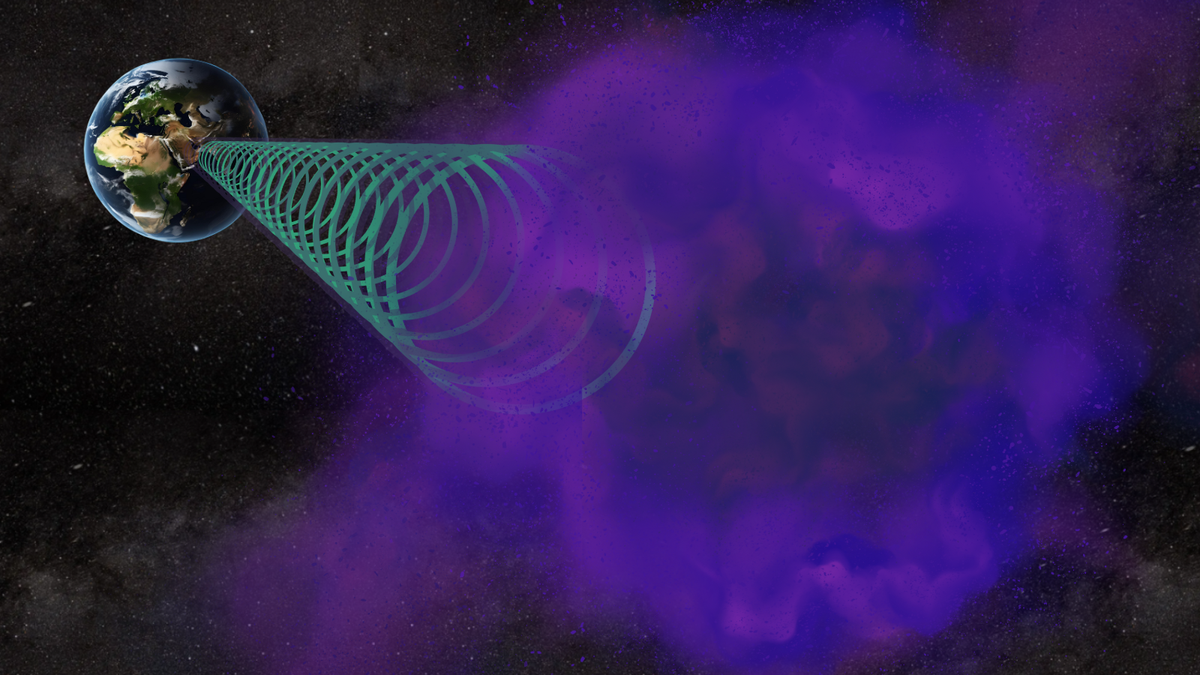Scientists use ‘cosmic radio’ detector to find elusive dark matter
Scientists build a quantum ‘cosmic radio’ detector to capture axions, moving closer to unraveling dark matter’s mysteries.

Scientists developed a groundbreaking “cosmic radio” using quantum materials. (CREDIT: Robert Lea)
Dark matter remains one of science's greatest mysteries, possibly making up 85% of all matter in the universe. Despite decades of research, its exact nature is unknown. One leading candidate to explain this invisible substance is the axion, a tiny particle proposed by physicists decades ago.
Now, researchers may finally have a tool to find these hidden particles—a detector described as a "cosmic radio" capable of capturing dark matter signals through specially engineered quantum materials.
In a breakthrough study published today in Nature, a global team from King’s College London, Harvard University, and UC Berkeley demonstrated the first clear detection of an axion-like entity, known as the Dynamical Axion Quasiparticle (DAQ).
This achievement brings scientists closer than ever to detecting real cosmic axions, potentially solving critical mysteries about dark matter and fundamental particle physics.
What Makes Axions So Special?
Axions were first theorized to resolve issues in quantum chromodynamics, the study of particles interacting through the strong nuclear force. They help explain why certain symmetries don't break down as expected in subatomic interactions, addressing the "strong CP problem."
Scientists also suggest axions make up dark matter, causing gravitational effects across galaxies but never directly observed. Until now, these elusive particles have remained purely theoretical.
David Marsh, a physicist at King’s College London, describes axions simply: “We can now build a dark matter detector that is essentially a cosmic car radio, tuning into the frequencies of the wider galaxy until we find the axion. We already have the technology, now it’s just a matter of scale and time.”
Related Stories
A New Particle from Quantum Materials
Unlike traditional searches for axions that look far into space, the researchers found an analogous particle in specialized quantum materials right here on Earth. They used an ultrathin crystal made from manganese bismuth telluride, just a few atoms thick, to uncover a particle closely resembling the theoretical axion. This crystal, known for its unusual magnetic and electronic behavior, was critical in detecting coherent oscillations—tiny, rhythmic vibrations that signal the DAQ.
For six years, Harvard scientist Jian-Xiang Qiu refined the technique to layer the crystal thinly enough for precise measurements. "Because this material is so sensitive to air, we needed to exfoliate it down to a few atomic layers to tune its properties accurately," Qiu explained. "This lets us observe fascinating physics and interactions with quantum entities like the axion."
The team combined ultrafast laser techniques and advanced electronic sensors to identify vibrations occurring at about 44 gigahertz. These oscillations were caused by a magnetic phenomenon called an antiferromagnetic magnon—essentially a wave-like disturbance in the spin alignment of magnetic atoms. Crucially, these magnons altered the crystal's electronic structure in a special way known as modulation of the "Berry curvature," a property governing electrons’ movement in quantum materials.
Quantum Materials Bridge Theory and Reality
The DAQ observed in manganese bismuth telluride directly mimics high-energy axions theorized by particle physicists. It arises from dynamic shifts in the material’s "θ-field," a property first introduced to describe magnetically sensitive insulators. Scientists previously viewed this field as static and fixed, used only to classify certain materials. However, the newly detected dynamical shifts indicate much richer physics, creating a particle-like excitation analogous to cosmic axions.
Researchers faced major hurdles in finding DAQs before this discovery. Most materials produce very weak signals, and the magnons required to induce DAQs are notoriously difficult to excite. The study's major advance was choosing the ideal magnetic fluctuations—antiferromagnetic magnons—that could strongly trigger measurable DAQs.
"These challenges have hindered experimental detection," noted Qiu. "Our critical advance was identifying the right material and experimental methods. This opens the door to even broader exploration."
Building a Detector for Cosmic Axions
The discovery has immediate implications for astrophysics and cosmology. The researchers propose using similar quantum materials to detect actual axions traveling through space. They imagine building a larger, more sensitive version of their crystal detector, capable of scanning frequencies across the electromagnetic spectrum.
Axions are predicted to oscillate at frequencies ranging from kilohertz—audible to humans—to extremely high terahertz frequencies. The DAQ observed in manganese bismuth telluride operates at the upper end of this spectrum. Researchers consider these high frequencies the most promising hunting ground for real cosmic axions.
Marsh's team anticipates constructing a fully operational axion detector within five years, followed by around ten years of frequency scanning. Their ultimate goal is definitive detection of dark matter axions, a landmark event equivalent to discovering the Higgs boson in particle physics.
"This is a really exciting time to be a dark matter researcher," Marsh said. "We’re closing in on the axion—and fast."
The Cosmic Radio: How it Works
To find cosmic axions, the new detector, humorously nicknamed a "cosmic car radio," would "tune" its frequency to match potential axion signals. When aligned correctly, the device would produce extremely faint flashes of light, indicating detection. Researchers believe scaling up their crystal-based technology is straightforward given current techniques.
"We already have the technology," said Marsh confidently. "It’s now just about scale."
Wider Applications Beyond Dark Matter
Beyond dark matter detection, DAQs offer exciting potential for quantum technologies. Researchers envision using the same mechanisms observed in manganese bismuth telluride to develop new types of quantum electronics and spin-based devices. Such advancements could revolutionize computing and information processing, exploiting ultrafast magnetism and quantum coherence in practical ways.
Additionally, insights gained from DAQs could enhance understanding of other quantum phenomena like superconductivity, where electrical currents flow without resistance, or topological states that give materials remarkable electronic robustness. The interplay of magnons, quantum fields, and DAQs creates endless opportunities for innovative research and practical application.
A Bright Future for Dark Matter Research
As scientists refine and expand their "cosmic radio," excitement grows within the research community. Marsh highlights the unprecedented attention axions currently receive: "There are as many papers now about axions as about the Higgs boson just before it was found."
With today's groundbreaking discovery, researchers now hold a crucial missing piece—a clear demonstration of DAQs—needed to fully bridge theory and reality. After decades of speculation, humanity may soon tune into the universe's hidden signals, unlocking secrets of the mysterious substance that shapes our cosmos.
Note: The article above provided above by The Brighter Side of News.
Like these kind of feel good stories? Get The Brighter Side of News' newsletter.
Joshua Shavit
Science & Technology Writer | AI and Robotics Reporter
Joshua Shavit is a Los Angeles-based science and technology writer with a passion for exploring the breakthroughs shaping the future. As a contributor to The Brighter Side of News, he focuses on positive and transformative advancements in AI, technology, physics, engineering, robotics and space science. Joshua is currently working towards a Bachelor of Science in Business Administration at the University of California, Berkeley. He combines his academic background with a talent for storytelling, making complex scientific discoveries engaging and accessible. His work highlights the innovators behind the ideas, bringing readers closer to the people driving progress.



